EIA: Gas-fired generators will account for majority of new electric generating capacity in 2018

The U.S. Energy Information Administration (EIA) projects that 21 gigawatts (GW) of natural gas-fired generators will be brought online in 2018, accounting for most of the 32 GW of total new electric generating capacity that’s expected to be added by the end of the year.
Renewable energy sources like wind and solar accounted for 98 percent of the 2 GW added in January and February. Based on reported timelines for gas-fired generators, however, EIA projects that 2018 will be the first year since 2013 in which renewables failed to account for a majority of new generating capacity.
“The newly added generating capacity in January and February 2018 included 2,029 megawatts (MW) of renewables, 27 MW of fossil fueled generators and 28 MW of other technologies, mostly consisting of energy storage batteries,” EIA reported. “In February 2018, for the first time in decades, all of the new generating capacity coming online within a month were non-fossil-fueled. Of the 475 MW of capacity that came online in February, 81 percent was wind, 16 percent was solar photovoltaic, and the remaining 3 percent was hydro and biomass.”
Renewable energy sources accounted for 55 percent of the 21 GW of additional U.S. capacity in 2017. Through February, renewables accounted for 22 percent of total operating U.S. electricity capacity. Based on data reported in the Preliminary Monthly Electric Generator Inventory, however, EIA reports that online dates for generators through the end of 2018 will outpace renewables.
Combined-cycle units that will be added to the PJM Regional Transmission Organization will account for about half of 21 GW of natural gas-fired generation capacity gains in 2018. Plans call for 5.2 GW of added capacity in Pennsylvania, 1.9 GW of added capacity in Maryland and 1.9 GW of added capacity in Virginia. Most of the new capacity will be added along the Transcontinental, the Dominion Transmission, and the Texas Eastern Transmission pipelines.
“Most of the 1,196 MW of new wind capacity that came online in January and February 2018 was added in states that already have significant wind capacity such as Texas, Oklahoma, and Iowa,” EIA reported. “In Texas, two utility-scale batteries totaling 20 MW were collocated at wind facilities. EIA expects five gigawatts of capacity to come online by the end of 2018. Of those 5 GW, 2 GW are in Texas, the state with the most wind capacity currently.
Meanwhile, Florida Power & Light completed four solar photovoltaic (PV) projects totaling 300 MW in January, and the company planned to bring an additional four projects totaling 300 MW online in March. By the end of 2018, new PV projects across the country are expected to add a total of 4 GW of added generating capacity, according to EIA.
